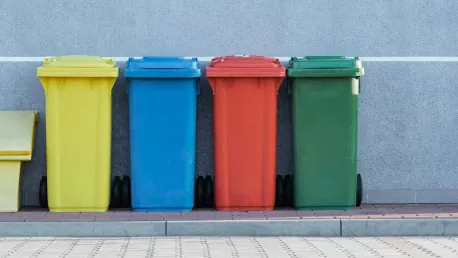Millions of tons of organic waste are generated globally each year from food, beverages, agriculture, and municipal sources. With increasing environmental concerns and regulatory pressures, sustainable waste management has become critical. By employing innovative processes, combined with technological advancements, we can convert organic waste into high-value products, benefiting the environment and economy alike.
The Scope of the Organic Waste Problem
Global Waste Production and Management
Municipal solid waste globally amounts to over two billion tonnes annually, and at least 33% of it is mismanaged. The average waste generated is 0.74 kg per person per day, with considerable variation across different regions. High-income countries, representing only 16% of the global population, produce about 34% of the world’s waste. By 2050, this number is expected to rise to 3.40 billion tonnes, posing a serious challenge that necessitates innovative solutions.The disparity in waste generation and management practices between different regions highlights a significant global issue. High-income countries often have the infrastructure and regulatory framework to manage waste efficiently, yet their high consumption rates lead to disproportionate waste production. In contrast, low-income regions suffer from inadequate waste management systems, resulting in significant environmental harm and public health risks. This growing problem calls for a multifaceted approach, integrating technological advancements and sustainable practices to mitigate the environmental impact and enhance the efficiency of waste management.
Regional Disparities and Increasing Pressures
Disparities exist in waste management practices between high-income and low-income regions. High-income countries often have better infrastructure and regulations but produce significant waste due to high consumption rates. In contrast, low-income countries struggle with inadequate waste management practices, leading to substantial environmental harm. These regional disparities and growing pressures highlight the urgent need for a multifaceted approach to waste management.Ineffective waste management in low-income countries not only poses environmental risks but also affects public health. Piles of uncollected waste can become breeding grounds for disease-causing organisms, exacerbating health problems. Furthermore, the lack of formal recycling systems in these regions means that valuable resources are often lost, which could otherwise be recovered and reused. Addressing these disparities requires coordinated efforts to develop robust waste management infrastructure and promote sustainable practices globally, ensuring that waste valorization benefits both the environment and the economy.
Innovative Technological Solutions
The Role of IoT and AI in Waste Management
Internet of Things (IoT) and Artificial Intelligence (AI) are transforming waste management. These smart technologies enable continuous monitoring of waste generation and management processes. For instance, sensors embedded in waste bins can alert when bins are full, optimizing collection routes and reducing operational costs. AI can analyze data to identify patterns and improve recycling efficiency, thus supporting sustainable initiatives.The integration of IoT and AI in waste management allows for more efficient and effective operations. IoT devices can monitor waste levels in real-time, ensuring that collection services are deployed only when necessary, thereby reducing fuel consumption and greenhouse gas emissions. AI algorithms can process vast amounts of data collected from these devices, identifying trends and providing actionable insights to improve recycling rates and reduce waste production at the source. These smart technologies not only enhance the efficiency of waste management systems but also contribute to the overall sustainability of waste valorization efforts.
Smart Technologies for Enhanced Efficiency
Smart technologies not only streamline operations but also contribute to waste reduction at the source. Automated systems can sort recyclables more accurately than human labor, ensuring higher quality of recovered materials. Moreover, IoT devices can track and reduce food waste in real-time by monitoring storage conditions and predicting spoilage, thereby extending the shelf life of perishable goods.The use of IoT-enabled smart bins and AI-driven sorting systems represents a significant leap forward in waste management. These technologies can accurately distinguish between different types of waste, increasing the purity and value of recycled materials. Additionally, smart sensors in food storage systems can monitor temperature and humidity levels, preventing food spoilage and reducing waste. This real-time monitoring capability allows for timely interventions, such as adjusting storage conditions or re-routing perishable goods to locations where they are most needed. By leveraging these advanced technologies, industries can minimize waste generation and improve the overall efficiency of waste management operations.
Bioprocessing Techniques for Waste Valorization
Solid-State Fermentation (SSF) and Submerged Fermentation (SmF)
Solid-State Fermentation (SSF) and Submerged Fermentation (SmF) are pivotal in converting organic waste into valuable bioactive compounds. SSF, which involves the cultivation of microorganisms on solid substrates without free water, is particularly effective for processing agricultural and food wastes. SmF, on the other hand, uses liquid substrates for microbial growth, suitable for waste streams with high moisture content. Both methods promote the extraction of enzymes, biofuels, and other bio-products.SSF and SmF processes leverage the metabolic capabilities of microorganisms to break down complex organic materials into simpler, valuable compounds. These bioprocesses are highly versatile, capable of producing a wide range of products, including biofuels, bioplastics, and specialty chemicals. By optimizing the conditions for microbial growth and metabolism, these fermentation techniques can maximize product yields and enhance the economic feasibility of waste valorization. Additionally, the use of agricultural and food wastes as substrates for fermentation reduces the reliance on virgin materials, promoting a more sustainable approach to resource utilization.
Hydrolysis and Advanced Extraction Processes
Hydrolysis and advanced extraction processes play crucial roles in breaking down complex organic materials into simpler compounds, which can be further processed into biofuels, bioplastics, and other high-value products. Hydrolysis involves the chemical breakdown of substances through the addition of water, aiding in the efficient extraction of nutrients. Advanced extraction techniques, such as supercritical fluid extraction, offer higher yields and purities of desired products, enhancing the economics of waste valorization.These bioprocessing techniques are essential for unlocking the full potential of organic waste. By breaking down complex molecules into their constituent parts, hydrolysis enables the efficient recovery of valuable nutrients and bioactive compounds. Advanced extraction methods, such as supercritical fluid extraction, utilize high-pressure fluids to selectively extract specific compounds from waste materials. These techniques offer several advantages, including higher extraction efficiencies, reduced solvent use, and the ability to tailor the extraction process to target specific products. The application of hydrolysis and advanced extraction processes in waste valorization not only enhances the economic viability of these initiatives but also supports the development of sustainable, high-value products from organic waste.
The Circular Economy Model
Integration of Innovation and Infrastructure
Adopting a circular economy model is essential for sustainable waste management. This model emphasizes the reuse, recycling, and recovery of resources, transforming waste into new products. By integrating innovation and robust infrastructure, industries can close the loop in product life cycles, reducing the reliance on virgin materials and minimizing waste.The circular economy approach promotes the development of closed-loop systems, where materials are continually reused and recycled, minimizing waste generation and resource depletion. This model encourages industries to innovate and invest in technologies that enable the efficient recovery of valuable resources from waste. By creating synergies between different sectors, such as agriculture, food production, and waste management, the circular economy fosters a more sustainable and resilient economic system. The integration of innovative technologies and robust infrastructure is critical for realizing the full potential of the circular economy, enabling industries to transform waste into valuable products and reduce their environmental footprint.
Applications in Agri-Food and Other Sectors
In the agri-food sector, circular economy practices can significantly reduce waste and enhance sustainability. For example, food waste can be converted into animal feed, fertilizers, and bioenergy. Such practices not only manage waste effectively but also contribute to food security and resource conservation. Beyond agri-food, sectors like textiles, packaging, and construction are also exploring circular models to manage organic waste better.The application of circular economy principles in the agri-food sector offers numerous benefits, including reduced waste, improved resource efficiency, and enhanced food security. By converting food waste into valuable products, such as animal feed and bioenergy, industries can create new revenue streams and reduce their reliance on non-renewable resources. Similarly, in other sectors like textiles and packaging, the adoption of circular practices can lead to significant environmental and economic gains. For example, textile waste can be recycled into new fabrics, reducing the demand for virgin materials and decreasing the environmental impact of textile production. By embracing the circular economy model, industries across various sectors can develop innovative solutions to manage organic waste, promote sustainability, and create a more resilient economic system.
Multidisciplinary Approach to Waste Management
Combining Biotechnology and Environmental Science
A multidisciplinary approach is crucial for the effective valorization of organic waste. Biotechnology offers advanced methods for bioprocessing and converting waste into valuable products. Environmental science contributes by studying the impact of waste and developing sustainable practices. Together, these fields provide comprehensive solutions to the waste problem, ensuring that valorization processes are environmentally benign and economically viable.The combination of biotechnology and environmental science enhances the ability to develop innovative and sustainable waste management practices. Biotechnology provides the tools and techniques needed to efficiently convert organic waste into valuable products, such as biofuels, bioplastics, and specialty chemicals. Environmental science, on the other hand, offers insights into the ecological impacts of waste and guides the development of practices that minimize environmental harm. By integrating these disciplines, researchers and practitioners can create comprehensive solutions that address both the technical and environmental aspects of waste valorization. This multidisciplinary approach ensures that waste management practices are not only effective and economically viable but also sustainable and environmentally friendly.
Role of Industrial Engineering and Digitalization
Each year, millions of tons of organic waste are produced globally from sources such as food, beverages, agriculture, and municipalities. With growing environmental concerns and tightening regulations, sustainable methods for managing this waste have become essential. The accumulation of organic waste not only poses a threat to the environment but also represents a missed economic opportunity. However, by integrating innovative processes and harnessing technological advancements, we can transform this waste into valuable products.For instance, organic waste can be converted into bioenergy, fertilizers, and animal feed, among other high-value products. These transformations help reduce the environmental impact by minimizing landfill use and lowering greenhouse gas emissions. Furthermore, this approach supports a circular economy, where waste materials are continuously repurposed, thus conserving natural resources and providing economic benefits to various sectors.Through investments in research and development, governments and businesses can collaborate to devise effective waste-to-resource technologies. Implementing these solutions requires infrastructure improvements, public awareness, and supportive policies. As we continue to innovate and adapt, the conversion of organic waste into valuable commodities will become an integral part of sustainable waste management practices, ultimately benefiting both the environment and the economy.









